| □ | The MKMSCS Central Station Monitoring Application provides the actual - on screen - presentation of all incoming Alarm Signals that need an Operator's Response (those classified as Active Signals), provides all necessary look-up utilities (e.g., alarm history look-up, password look-up, system information look-up), displays system and central station status information, and provides the Alarm Signal Processing system and automates the display of the required Operator follow-up procedures. |
| • | Although MKMSCS is a separate application, it uses the Central Station Monitoring data entered through MKMS as detailed in the previous chapters (note the list below). |
| • | Before starting to use this Central Station Monitoring Application to Process Alarms, all data entry requirements outlined below, should be completed: |
| □ | General Features and Functionality of the Central Station Monitoring Application |
| • | The Processing of Alarm Signals can be a difficult and stressful occupation. |
| • | Mistakes - particularly during high traffic periods - are easily made and could result in catastrophic consequences. |
| • | This Central Station Monitoring Application is designed specifically to reduce stress, streamline alarm processing, eliminate mistakes, and assure prompt and accurate responses to all Active Signals. |
| • | Among the many features and benefits the MKMSCS Central Station Monitoring Application provides are: |
| • | Pre-programmed - step by step - procedures for all alarm events. |
| • | The use of color to direct an Operator's attention to the proper screen location. |
| • | Quick access function keys to activate all the repetitive actions and look-ups. |
| □ | Logging In to the MKMSCS Central Station Monitoring Application |
| • | Because you will be using multiple applications - all relating to your Monitoring processes - consider creating a folder on your Windows® Desktop with Shortcuts to all programs each workstation will be needing. |
| • | Example of a Windows® Desktop Shortcuts folder: |
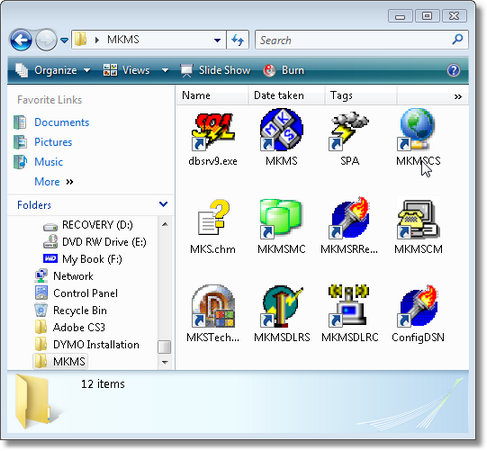
MKMS Desktop folder with Application Shortcuts
| • | Not all workstations will need all of these applications. |
| ▪ | SPA need only be running on the computer(s) to which your Receivers (or multi-port devices for your Receivers) are actually connected. |
| • | Start the MKMSCS application. |
| • | Select the appropriate database name (if you're using the Multiple Companies feature), then tab to the Name field. |
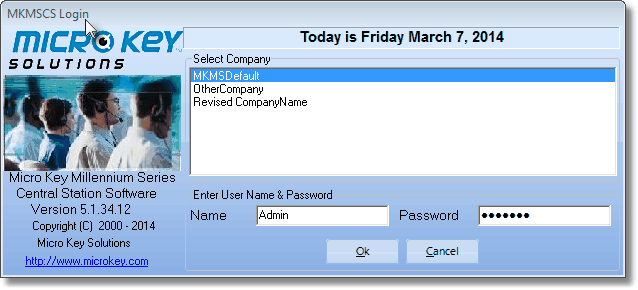
MKMSCS Login dialog
| • | Click the OK button to complete the login process. |
| □ | Signals To Process - The Signals To Process dialog will be displayed. |
| ► | Note 2: If the Operator does not have Central Station Supervisor Access Rights Checked in the Security tab of the Employee Form, this dialog will not be displayed. |
| ▪ | By default, All Operator Skills assigned to the Central Station Supervisor/Operator (who has just Logged In) are Checked. |
| ▪ | By default, All Group Names assigned to the Central Station Supervisor/Operator (who has just Logged In) are Checked. |
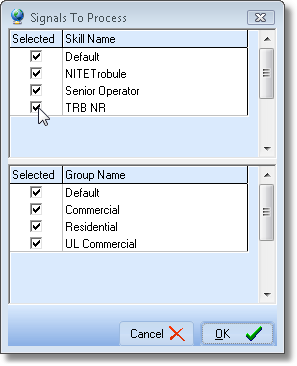
Signals To Process dialog for Supervisor
| • | A Central Station Supervisor may re-set their own Operator Skills assignments - which Signals To Process will be accessible to that Central Station Supervisor/Operator - while non-supervisory Operators will not see this dialog. |
| • | The Employee designated as a Central Station Supervisor must be assigned an Employee Type of either Operator or All on the Personal tab of the Employees Form. |
| • | To designate an individual as an actual Central Station Supervisor, Check the Central Station Supervisor? box on the Security tab of the Employees Form. |
| • | Selected - By default, all of the Skill(s) that the Central Station Supervisor/Operator User has been assigned will be listed and Checked. |
| ▪ | Based on the needs of the Central Station such as the number of Operators that are already Processing Alarms for these Skills and the number of Accounts requiring these Skills, a Central Station Supervisor may Uncheck one or more of these Skill Assignments. |
| ▪ | By doing so, this Central Station Supervisor/Operator will not be required to Process any of the Alarm Signals in the Alarm Stack requiring those unlisted or Unchecked Skills. |
| ▪ | At least One Skill must remain Checked or an exception error message will be displayed. |
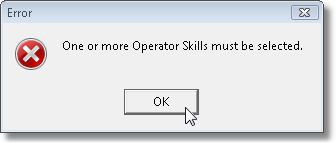
One or more Operator Skills must be selected
| • | Selected - By default, the Alarm Group(s) to which the User has been assigned will be listed and Checked. |
| ▪ | Based on the needs of the Central Station such as the number of Operators that are already Processing Alarms for these Alarm Groups and the number of Accounts assigned to these Groups, a Central Station Supervisor may Uncheck one or more of these Alarm Processing Group assignments. |
| ▪ | By doing so, you the User (Operator).will not be required to Process any of the Alarm Signals requiring these unlisted or Unchecked Alarm Groups. |
| ▪ | At least One Alarm Group must remain Checked or an exception error message will be displayed. |
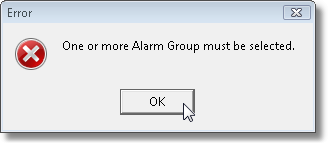
One or more Alarm Groups must be selected
| • | Click the OK button to complete the Skills and Groups assignment process. |
| • | A Central Station Supervisor/Operator Warning message will be displayed indicating which Skills and Groups are currently not being serviced. |
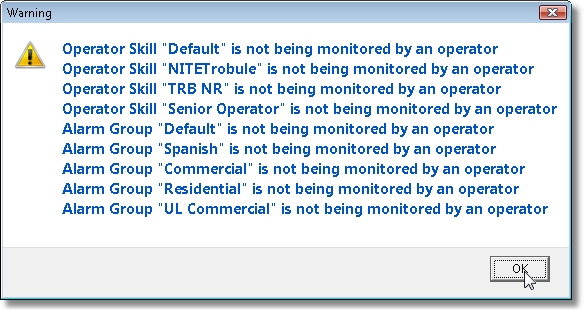
| • | Activate the Processing function for the appropriate Operators workstations to "relieve" this deficiency. |
| □ | Using the Central Station Alarm Monitoring Application Menu Options: |
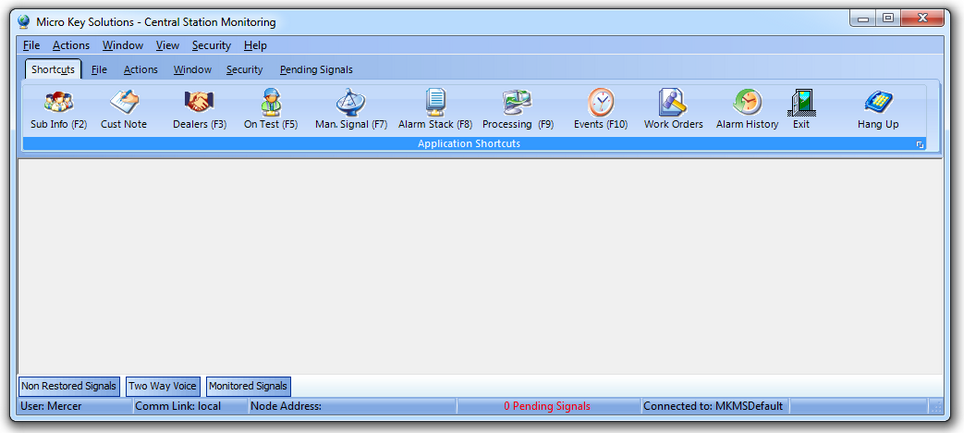
MKMSCS Desktop with All Menus and tabs displayed
| • | Each item on the Main Menu offers a subordinate sub-menu with multiple options. |
| • | The options available from the Main Menu are listed below, and explained in more detail in The Main Menu chapter: |

Central Station Monitoring - Main Menu at the top of the Form
| • | File - Allows maintenance operations on the Log Files for MKMSCS and Exiting from MKMSCS. |
| • | Window - Arrange the Central Station Monitoring Application Desktop, as desired. |
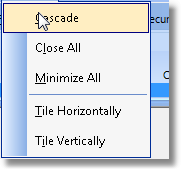
| ▪ | Not all windows within MKMSCS may be Re-sized because of program restrictions to assure that certain critical information will always be visible to the Operator. |
| ▪ | Because of "forced sizing" restrictions, some Forms may not be able to be Re-sized, as desired. |
| • | View - Allows you to turn off/on the Shortcuts (see below) Toolbar. |
| • | Security - Provides the Log out, Shift Change and Login functions. |

| ▪ | Log out Ctrl+F9 - Press Ctrl+F9 to log off from the Central Station Monitoring Application. |
| ▪ | Shift Change Shift+F9 - Press Shift+F9 to execute a Shift Change procedure which avoids the need to Close the Processing function while switching Operators. |
| ▪ | Login - If an Operator Logged Out without using the Shift Change function, use Log In to access the Central Station Monitoring Application at this workstation. |
| • | Help - Select Function Key Help F12 (or just Press F12) from the Help Menu to see the basic Central Station Function Key Listing chart shown below. |
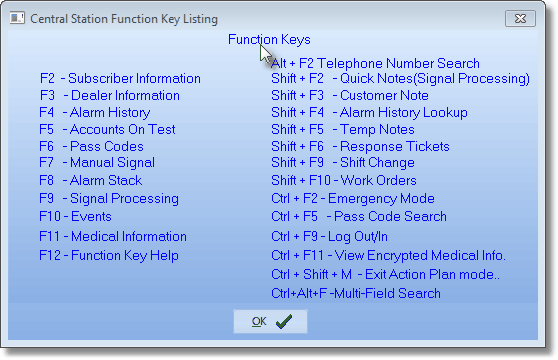
F12 - Central Station Function Key Listing
| ► | Note: Help Files are no longer accessed by pressing F1. |
| a) | Help Files for MKMS and MKMSCS run as a separate stand-alone application (MKS.chm) from your Windows® Desktop. |

Shortcuts tab in the Central Station Monitoring application
These include:
| • | Sub Info - Press F2 to open the Subscriber Information Form, from which all related Monitoring Information may be viewed. |
| • | Cust Note - Press Shift+F3 to open the Customer Notes dialog. |
| • | Dealers - Press F3 to open the Dealer Information Form. |
| • | On Test - Press F5 to the Panel Test Information dialog. |
| • | Alarm Stack - Press F8 to view a listing of all Pending and On Hold Alarm Signals. |
| • | Processing - Press F9 to start the Alarm Processing process at this workstation. |
| • | Events - Press F10 to view all of the pending Supervised Events. |
| • | Work Orders - Press Shift+F10 to create a Service Request. |
| • | Alarm History - Press Shift+F4 to open the Alarm History Lookup dialog. |
| • | Exit - Click the Exit button to Close the MKMSCS application. |
| • | Hang Up - Press the Hang Up button to manually disconnect your Modem from the Telephone Line (see Configuration below). |
| □ | Using the features on the Actions Toolbar tab: |

Actions tab in the Central Station Monitoring application















